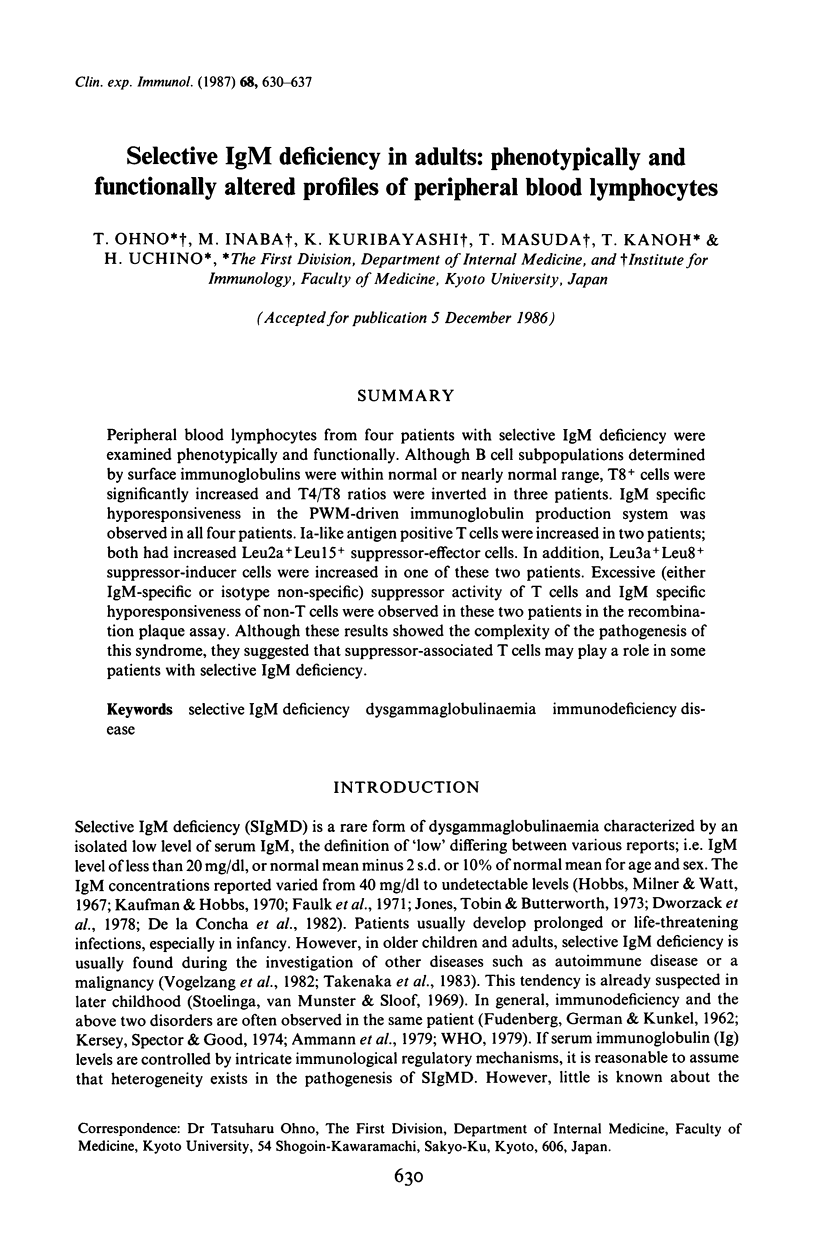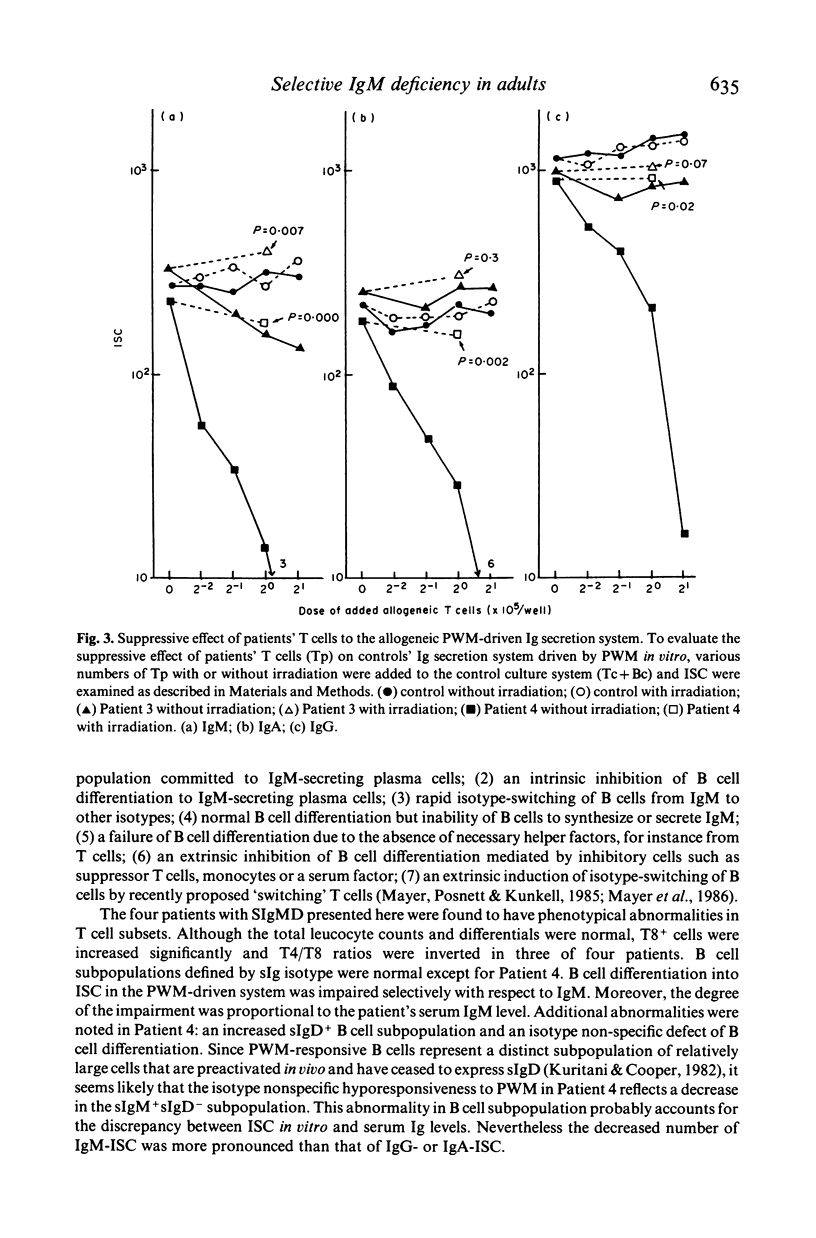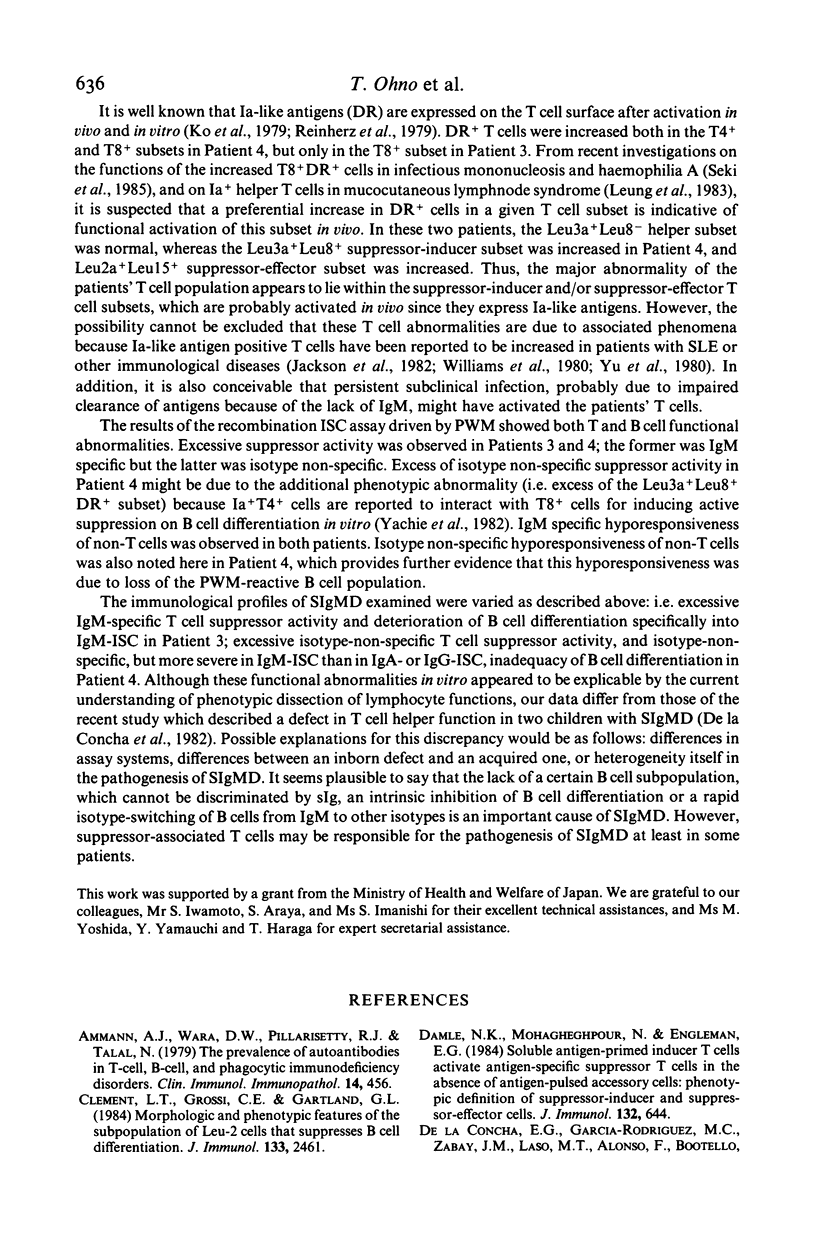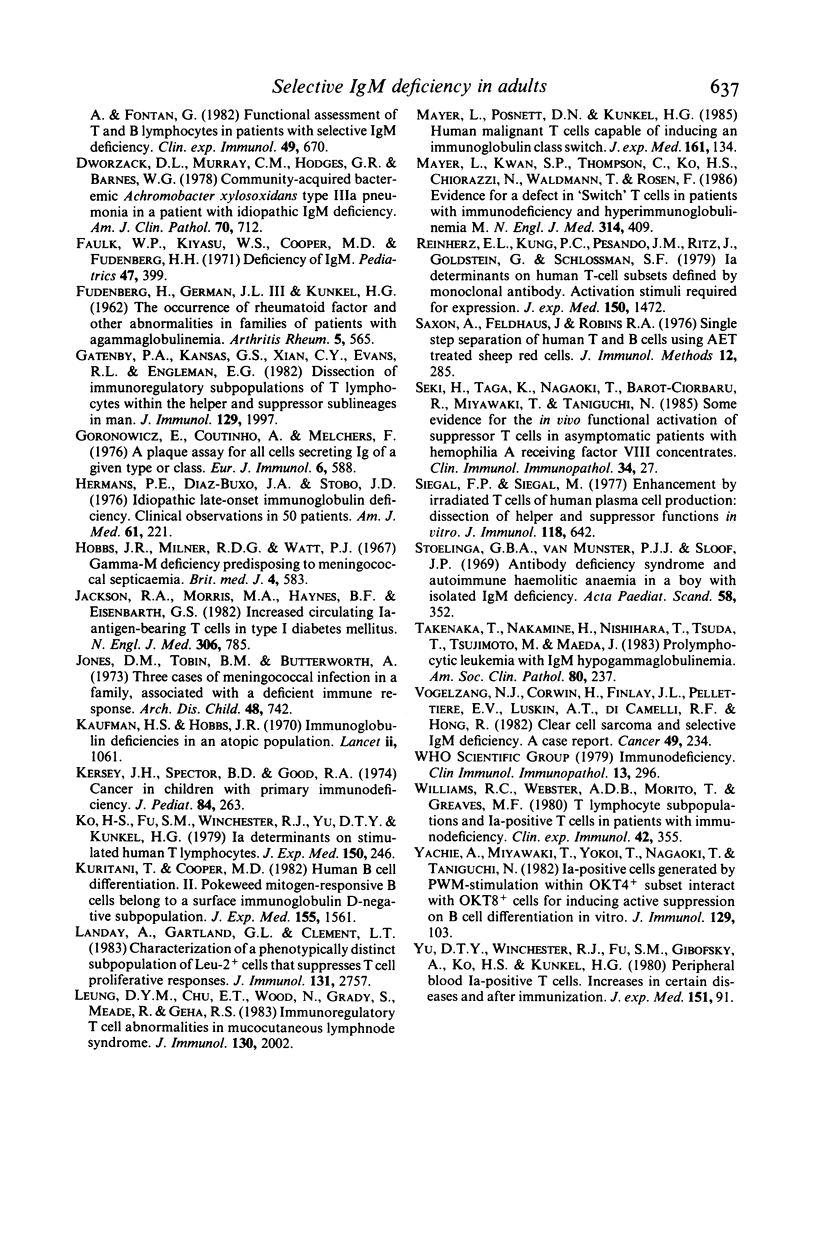Abstract
Peripheral blood lymphocytes from four patients with selective IgM deficiency were examined phenotypically and functionally. Although B cell subpopulations determined by surface immunoglobulins were within normal or nearly normal range, T8+ cells were significantly increased and T4/T8 ratios were inverted in three patients. IgM specific hyporesponsiveness in the PWM-driven immunoglobulin production system was observed in all four patients. Ia-like antigen positive T cells were increased in two patients; both had increased Leu2a+ Leu15+ suppressor-effector cells. In addition, Leu3a+ Leu8+ suppressor-inducer cells were increased in one of these two patients. Excessive (either IgM-specific or isotype non-specific) suppressor activity of T cells and IgM specific hyporesponsiveness of non-T cells were observed in these two patients in the recombination plaque assay. Although these results showed the complexity of the pathogenesis of this syndrome, they suggested that suppressor-associated T cells may play a role in some patients with selective IgM deficiency.
Full text
PDF







Selected References
These references are in PubMed. This may not be the complete list of references from this article.
- Ammann A. J., Wara D. W., Pillarisetty R. J., Talal N. The prevalence of autoantibodies in T-cell, B-cell, and phagocytic immunodeficiency disorders. Clin Immunol Immunopathol. 1979 Dec;14(4):456–466. doi: 10.1016/0090-1229(79)90098-9. [DOI] [PubMed] [Google Scholar]
- Clement L. T., Grossi C. E., Gartland G. L. Morphologic and phenotypic features of the subpopulation of Leu-2+ cells that suppresses B cell differentiation. J Immunol. 1984 Nov;133(5):2461–2468. [PubMed] [Google Scholar]
- Damle N. K., Mohagheghpour N., Engleman E. G. Soluble antigen-primed inducer T cells activate antigen-specific suppressor T cells in the absence of antigen-pulsed accessory cells: phenotypic definition of suppressor-inducer and suppressor-effector cells. J Immunol. 1984 Feb;132(2):644–650. [PubMed] [Google Scholar]
- De la Concha E. G., Garcia-Rodriguez M. C., Zabay J. M., Laso M. T., Alonso F., Bootello A., Fontan G. Functional assessment of T and B lymphocytes in patients with selective IgM deficiency. Clin Exp Immunol. 1982 Sep;49(3):670–676. [PMC free article] [PubMed] [Google Scholar]
- Dworzack D. L., Murray C. M., Hodges G. R., Barnes W. G. Community-acquired bacteremic Achromobacter xylosoxidans type IIIa pneumonia in a patient with idiopathic IgM deficiency. Am J Clin Pathol. 1978 Oct;70(4):712–717. doi: 10.1093/ajcp/70.4.712. [DOI] [PubMed] [Google Scholar]
- FUDENBERG H., GERMAN J. L., 3rd, KUNKEL H. G. The occurrence of rheumatoid factor and other abnormalities in families of patients with agammaglobulinemia. Arthritis Rheum. 1962 Dec;5:565–588. doi: 10.1002/art.1780050605. [DOI] [PubMed] [Google Scholar]
- Faulk W. P., Kiyasu W. S., Cooper M. D., Fudenberg H. H. Deficiency of IgM. Pediatrics. 1971 Feb;47(2):399–404. [PubMed] [Google Scholar]
- Gatenby P. A., Kansas G. S., Xian C. Y., Evans R. L., Engleman E. G. Dissection of immunoregulatory subpopulations of T lymphocytes within the helper and suppressor sublineages in man. J Immunol. 1982 Nov;129(5):1997–2000. [PubMed] [Google Scholar]
- Gronowicz E., Coutinho A., Melchers F. A plaque assay for all cells secreting Ig of a given type or class. Eur J Immunol. 1976 Aug;6(8):588–590. doi: 10.1002/eji.1830060812. [DOI] [PubMed] [Google Scholar]
- Hermans P. E., Diaz-Buxo J. A., Stobo J. D. Idiopathic late-onset immunoglobulin deficiency. Clinical observations in 50 patients. Am J Med. 1976 Aug;61(2):221–237. doi: 10.1016/0002-9343(76)90173-x. [DOI] [PubMed] [Google Scholar]
- Hobbs J. R., Milner R. D., Watt P. J. Gamma-M deficiency predisposing to meningococcal septicaemia. Br Med J. 1967 Dec 9;4(5579):583–586. doi: 10.1136/bmj.4.5579.583. [DOI] [PMC free article] [PubMed] [Google Scholar]
- Jackson R. A., Morris M. A., Haynes B. F., Eisenbarth G. S. Increased circulating Ia-antigen-bearing T cells in type I diabetes mellitus. N Engl J Med. 1982 Apr 1;306(13):785–788. doi: 10.1056/NEJM198204013061305. [DOI] [PubMed] [Google Scholar]
- Jones D. M., Tobin B. M., Butterworth A. Three cases of meningococcal infection in a family, associated with a deficient immune response. Arch Dis Child. 1973 Sep;48(9):742–743. doi: 10.1136/adc.48.9.742. [DOI] [PMC free article] [PubMed] [Google Scholar]
- Kaufman H. S., Hobbs J. R. Immunoglobulin deficiencies in an atopic population. Lancet. 1970 Nov 21;2(7682):1061–1063. doi: 10.1016/s0140-6736(70)90288-6. [DOI] [PubMed] [Google Scholar]
- Kersey J. H., Spector B. D., Good R. A. Cancer in children with primary immunodeficiency diseases. J Pediatr. 1974 Feb;84(2):263–264. doi: 10.1016/s0022-3476(74)80619-0. [DOI] [PubMed] [Google Scholar]
- Ko H. S., Fu S. M., Winchester R. J., Yu D. T., Kunkel H. G. Ia determinants on stimulated human T lymphocytes. Occurrence on mitogen- and antigen-activated T cells. J Exp Med. 1979 Aug 1;150(2):246–255. doi: 10.1084/jem.150.2.246. [DOI] [PMC free article] [PubMed] [Google Scholar]
- Kuritani T., Cooper M. D. Human B cell differentiation. II. Pokeweed mitogen-responsive B cells belong to a surface immunoglobulin D-negative subpopulation. J Exp Med. 1982 May 1;155(5):1561–1566. doi: 10.1084/jem.155.5.1561. [DOI] [PMC free article] [PubMed] [Google Scholar]
- Landay A., Gartland G. L., Clement L. T. Characterization of a phenotypically distinct subpopulation of Leu-2+ cells that suppresses T cell proliferative responses. J Immunol. 1983 Dec;131(6):2757–2761. [PubMed] [Google Scholar]
- Leung D. Y., Chu E. T., Wood N., Grady S., Meade R., Geha R. S. Immunoregulatory T cell abnormalities in mucocutaneous lymph node syndrome. J Immunol. 1983 May;130(5):2002–2004. [PubMed] [Google Scholar]
- Mayer L., Kwan S. P., Thompson C., Ko H. S., Chiorazzi N., Waldmann T., Rosen F. Evidence for a defect in "switch" T cells in patients with immunodeficiency and hyperimmunoglobulinemia M. N Engl J Med. 1986 Feb 13;314(7):409–413. doi: 10.1056/NEJM198602133140703. [DOI] [PubMed] [Google Scholar]
- Mayer L., Posnett D. N., Kunkel H. G. Human malignant T cells capable of inducing an immunoglobulin class switch. J Exp Med. 1985 Jan 1;161(1):134–144. doi: 10.1084/jem.161.1.134. [DOI] [PMC free article] [PubMed] [Google Scholar]
- Reinherz E. L., Kung P. C., Pesando J. M., Ritz J., Goldstein G., Schlossman S. F. Ia determinants on human T-cell subsets defined by monoclonal antibody. Activation stimuli required for expression. J Exp Med. 1979 Dec 1;150(6):1472–1482. doi: 10.1084/jem.150.6.1472. [DOI] [PMC free article] [PubMed] [Google Scholar]
- Saxon A., Feldhaus J., Robins R. A. Single step separation of human T and B cells using AET treated srbc rosettes. J Immunol Methods. 1976;12(3-4):285–288. doi: 10.1016/0022-1759(76)90050-8. [DOI] [PubMed] [Google Scholar]
- Seki H., Taga K., Nagaoki T., Barot-Ciorbaru R., Miyawaki T., Taniguchi N. Some evidence for the in vivo functional activation of suppressor T cells in asymptomatic patients with hemophilia A receiving Factor VIII concentrates. Clin Immunol Immunopathol. 1985 Jan;34(1):27–38. doi: 10.1016/0090-1229(85)90004-2. [DOI] [PubMed] [Google Scholar]
- Siegal F. P., Siegal M. Enhancement by irradiated T cells of human plasma cell production: dissection of helper and suppressor functions in vitro. J Immunol. 1977 Feb;118(2):642–647. [PubMed] [Google Scholar]
- Stoelinga G. B., van Munster P. J. Antibody deficiency syndrome and autoimmune haemolytic anaemia in a boy with isolated IgM deficiency dysimmunoglobulinaemia type 5. Acta Paediatr Scand. 1969 Jul;58(4):352–362. doi: 10.1111/j.1651-2227.1969.tb04731.x. [DOI] [PubMed] [Google Scholar]
- Takenaka T., Nakamine H., Nishihara T., Tsuda T., Tsujimoto M., Maeda J. Prolymphocytic leukemia with IgM hypogammaglobulinemia. Am J Clin Pathol. 1983 Aug;80(2):237–242. doi: 10.1093/ajcp/80.2.237. [DOI] [PubMed] [Google Scholar]
- Vogelzang N. J., Corwin H., Finlay J. L., Pellettiere E. V., 2nd, Luskin A. T., Di Camelli R. F., Hong R. Clear cell sarcoma and selective IgM deficiency: a case report. Cancer. 1982 Jan 15;49(2):234–238. doi: 10.1002/1097-0142(19820115)49:2<234::aid-cncr2820490207>3.0.co;2-h. [DOI] [PubMed] [Google Scholar]
- Williams R. C., Jr, Webster A. D., Morito T., Greaves M. F. T lymphocyte subpopulations and Ia-positive T cells in patients with immunodeficiency. Clin Exp Immunol. 1980 Nov;42(2):355–363. [PMC free article] [PubMed] [Google Scholar]
- Yachie A., Miyawaki T., Yokoi T., Nagaoki T., Taniguchi N. Ia-positive cells generated by PWM-stimulation within OKT4+ subset interact with OKT8+ cells for inducing active suppression on B cell differentiation in vitro. J Immunol. 1982 Jul;129(1):103–106. [PubMed] [Google Scholar]
- Yu D. T., Winchester R. J., Fu S. M., Gibofsky A., Ko H. S., Kunkel H. G. Peripheral blood Ia-positive T cells. Increases in certain diseases and after immunization. J Exp Med. 1980 Jan 1;151(1):91–100. doi: 10.1084/jem.151.1.91. [DOI] [PMC free article] [PubMed] [Google Scholar]


